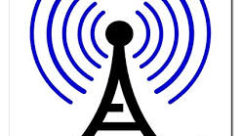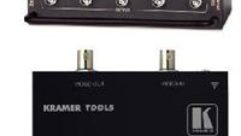Understanding Video and other unbalanced interfaces.
May 1, 1998 12:00 PM,
Bill Whitlock
Ground noise is a rich mixture of power line harmonics and any otherhigh-frequency noises that exist on the power line-think about listening tothe power line with the treble turned way up (don’t try this at home!).Ground noise should not be confused with plain old noise, which is more orless uniformly spread across the signal spectrum, heard in an audio systemas the sound of a waterfall or seen in a video system as grainy movement orsnow. A predictable amount of this (Gaussian) electronic noise is inherentin all electronic devices and must be expected. Ground noise producesartifacts such as hum, buzz, clicks or pops in audio systems and slowly rolling dark bars, bands of specks or herringbone patterns in video systems.In last month’s column we explained that, in real world systems, significantground noise currents will flow in any wire connecting two devices, andthat significant ground noise voltages will exist between the local groundsof these two devices. This column will explain why unbalanced interfaceslack any inherent ability to suppress the effects of these ground noisecurrents and voltages, making them particularly vulnerable to hum and otherso-called ground-loop problems. Unfortunately, both standard 75 W coaxialvideo and standard consumer audio are such unbalanced interfaces.
Just how much ground noise is tolerable depends on whether the signal isaudio or video and the expected level of performance from the system.Obviously, an audio monitoring system in a recording studio needs to bemuch more immune to ground noise and interference than a paging system at aconstruction site. In general, video systems can tolerate more interferencethan audio systems. For broadcast video, a S/N ratio of 40 dB is consideredexcellent, and even expert viewers find it difficult to detect interferenceat -50 dB. On the other hand, a 1995 AES paper by Louis Fielder of DolbyLabs suggests that, for audio reproduction in a home listening situation,the threshold may be about -120 dB.
Common-impedance coupling Unbalanced interfaces use two-conductorconnectors and cable having two coaxial conductors, often called singleconductor shielded cable. The most widely used connectors are the RCA(properly IHF) or two-conductor 1/4 inch (6 mm) phone (or TS fortip/sleeve) for audio signals, the BNC or RCA for 75 W video signals, the Ffor 75 W RF signals and various RS-232 connectors for data interfaces.
As shown in Figure 1, ground noise current will flow in any wire connectedbetween points A and B. Because the wire has impedance, a small voltagedrop will appear across it. In an unbalanced interface, this wire alsocarries the signal. The signal actually delivered to device B is the sum ofall the voltages in the loop from points A to C. Because the wire’simpedance is common to both signal and ground noise current paths, thiscoupling mechanism is called common impedance coupling. Common impedancecoupling happens when two currents flow in the same conductor.
The common impedance includes the shield impedance of the cable and theshield contact resistance at each connector. The impedance of the cable’sinner conductor has negligible effect on the coupling because it is inseries with the much higher impedances of device A’s output and device B’sinput.
At power line (hum) frequencies, the impedance of a wire (or cable shield)is effectively equal to its DC resistance. According to Ohm’s Law, E = I xR. Therefore, the low-frequency noise voltage, E, depends upon the groundnoise current, I, and the resistance, R, of the cable shield. Consider a 25foot (7.6 m) interconnect cable with foil shield and an AWG #26 drain wire.
>From standard wire tables, its shield resistance is calculated to be 0.41W. If the ground noise current is 300 mA, the ground noise voltage will be300 mV. Because the normal reference signal level for consumer audio is 300mV, the noise is 20 x log (300 mV/300 mV), or only 60 dB below a referencesignal.
Ground noise current for floating (two-prong AC plug) equipment is usuallyrelated to the equipment’s power consumption, which dictates the size, andtherefore the primary to secondary capacitance of its power transformer. Itis this power transformer capacitance that causes the ground noise currentsto circulate in the first place. Ground noise current can range from a fewmicroamps for a turntable or CD player to nearly a milliamp for an audiopower amp or video monitor.
Ground noise current for grounded (three-prong AC plug) equipment can bevery high, because the ground noise in the building’s wiring is effectivelyforced across the unbalanced cable’s shield. Currents may reach 100 mA and,in some situations, noise voltage may actually be larger than the referencesignal.
Reducing the coupling Ground noise coupling is an inherent weakness inunbalanced interfaces, and the coupling becomes worse as cables get longerand equipment power supply connections become physically farther apart. Inspite of this, unbalanced interfaces seem to be well entrenched, even invery large audio and video systems where trouble is virtually guaranteed.There are only two ways to reduce ground noise coupling.
First, reduce the impedance of the shield. Keep cables as short aspossible. Longer cables increase the coupling impedance. Also, use cableswith heavy gauge shields. Cables with shields of foil and thin gauge drainwires increase coupling impedance. Use cables with braided copper shields.The only property of cable that has any significant effect on noisecoupling is shield resistance. Maintain good connections. Connectors leftundisturbed for long periods can develop high contact resistance. Hum orother interference that changes when the connector is wiggled indicates apoor contact. Use a good commercial contact fluid and/or gold-platedconnectors.
Second, reduce the circulating ground current. Don’t add unnecessarygrounds. Additional grounding of equipment generally increases circulatingground noise currents. Never, never disconnect or lift a safety ground orlightning protection ground to solve a problem; the practice is bothillegal and very dangerous. Use ground isolators at problem interfaces.These isolators pass the signal while electrically breaking the shieldpath. This stops the ground noise current flow and the resulting coupling.A number of commercial isolators are available for audio, video and CATVsignal paths.
Ground isolators There are two basic types of ground isolators. Activedevices use differential amps. Most diff-amp circuits make poor receiversfor balanced audio lines and are nearly useless for unbalanced lines. Theycan’t deal with ground noise voltages over about 10 V, even for spikes, andthey usually use integrated circuits prone to degradation or failure causedby such transients. The Sonance AGI-1 is an example of such a device foraudio.
Passive devices use transformers. Their tolerance of source impedance,which makes them excellent receivers for balanced lines, makes themoutstanding isolators for unbalanced lines. They require no power and areessentially immune to voltage transients and RFI. The ISO-MAX CI-2RR is anaudiophile-grade ground isolator for audio.
Figure 2 compares 60 Hz hum rejection of the above-mentioned audioisolators. Over the 200 W to 1,000 W range of typical consumer source(output) impedances, the active isolator can achieve only 15 dB to 30 dB ofhum rejection. Under the same operating conditions, the passive isolatorachieves 90 dB to 110 dB.
Cable shielding and RFI Unbalanced interconnect cables are also subject tonoise pickup via magnetic and/or electrostatic induction effects. Unlikebalanced cables, this pickup cannot be nullified by the receiving input.The cable’s outer shield, if it completely surrounds the inner conductor,prevents electrostatic noise pickup. Foil shields usually have this 100%coverage. Braided shields, because they are woven and have small openings,generally vary from 80% to 95%, but they are adequate for all but extremecases.
Likewise, strong AC magnetic fields radiate from any conductor operating ata high AC current. Building wiring, power transformers, electric motors andCRT displays are a few sources of very strong AC magnetic fields. Becauseof the impedance imbalance, unbalanced interfaces cannot take fulladvantage of twisted or coaxial cable construction to nullify magneticnoise pickup. Strong AC fields very near cables will induce significantnoise. Increasing the distance between cables, and the offending magneticfield will always reduce pickup. Cable shielding, whether copper braid oraluminum foil, has no significant effect on magnetic fields.
The ability of equipment to reject high-frequency ground noise or RFIdepends upon how well it isdesigned. Sadly, the performance of mostcommercial equipment degrades when such interference is coupled to itsinput. Symptoms can range from actual detection of radio, CB or televisionsignals, heard as music, voices or buzz in the case of television signals,to much more subtle distortions, often described as a veiled or grainyquality in the reproduced audio. Video, RF and data systems can exhibit awide range of symptoms.
Designer cables Beware of marketing hype. In my opinion, much of theunexplainable audible differences among audio cables is due to unrecognizedvariations in ultrasonic and RF common impedance coupling. Even low levelsof such high frequencies coupled to (mixed with) an audio signal are knownto cause spectral contamination in any downstream active device (amp). Itseems obvious to me that the real solution is to prevent the coupling inthe first place with a ground isolator, not agonize over which designercable makes the most pleasing small improvement.
Some designer cables have very high capacitance and will seriously degradehigh frequency response, especially if used on a long cable run driven by ahigh-impedance consumer device. For such applications, consider a low-capacitance, low shield-resistance cable such as Belden’s #8241F. Forexample, its 17 pF per foot (0.3 m) capacitance allows driving a 200 foot(61 m) run from a 1,000 W output while maintaining a -3 dB bandwidth of 50kHz. Its 2.6 mW per foot (0.3 m) shield resistance is equivalent to AWG #14wire, minimizing common impedance coupling. It is also quite flexible andavailable in many colors.
Finally, marketers of some designer cables imply that audio cables behaveas transmission lines. Real science tells us that audio cables are nottransmission lines in the engineering sense and don’t require low-impedancetermination networks until they reach thousands of feet in physical length.
In an upcoming column, we’ll discuss the limitations of power linetreatments such as power isolation transformers and so-called balancedpower in dealing with ground noise.









